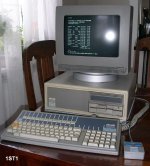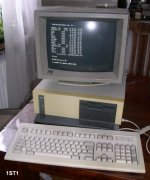Upcoming Events:
- VCF South West - June 14 - 16, Davidson-Gundy Alumni Center at University of Texas at Dallas
- VCF West - Aug 2 - 3, Computer History Museum, Mountain View, CA
- VCF Midwest - Sept 7 - 8 2024, Schaumburg, IL
- VCF SoCal - Mid February 2025, Location TBD, Southern CA
- VCF East - April 2025, Infoage Museum, Wall NJ
-
Please review our updated Terms and Rules here
- Forums
- Companies
- IBM Computers, PCs, Clones and Descendants
- PCs and Clones (XT and early AT class machines)
You are using an out of date browser. It may not display this or other websites correctly.
You should upgrade or use an alternative browser.
You should upgrade or use an alternative browser.
New items in my collection: Olivetti M24 with Color Monitor, ATARI PC3
- Thread starter 1ST1
- Start date
1ST1
Veteran Member
They both need a cleanup. Also my good old NEC Multisync. It's just a 1st test in their new home.
Tor
Veteran Member
I always liked the Olivetti M24 design (which was used for some other models too). Looks much better than, say, an IBM 5150. IMO.
Last edited:
1ST1
Veteran Member
By the way, have you noticed that ultra rare Olivetti keyboard connected mouse? It has been made by a company which still used to be very unknown in 1983 when this thing has been introduced... Logitech.
Trixter
Veteran Member
I am also a fan of the M24 and its derivatives. The motherboard is mounted such that the DIP switches, sockets, etc. are all facing the bottom of the unit, and you can turn it upside down and remove just the bottom cover to get at them. This means you don't have to remove any floppy drives or cards from the system to flip a switch, add RAM, etc. I thought it was great, and it saved space too (it has a small desktop footprint).
The biggest and most obvious M24/6300/Xerox downsides are the proprietary keyboard and monitor connections.
The biggest and most obvious M24/6300/Xerox downsides are the proprietary keyboard and monitor connections.
Trixter
Veteran Member
I have to run the 8088MHZ demo onto them.
I'm flattered, but it likely will not run properly. Worse, since there is no way to get composite video out of an M24, there is no chance the colors will be even remotely accurate.
If you are new to the M24, here's a video overview of that series.
1ST1
Veteran Member
I know the M24 since 29 years, I have service manual, circuit diagrams and functional description ("M24 - Theory of Operation" - it describes the machine down to TTL logics/GAL listing level) and so on. This is my 3rd M24, the first one which works fully properly. A 2nd can not read any floppydisk (drives swapped, no change) and the 3rd has broken powersupply. I have also other Olivetti PCs: M19, ETV 260, ETV 2700, M380XP1 (powersupply broken), LSX-5020 (486-EISA machine, currently dismantled for recostruction, ODIN RTC chip battery repair). I already tryed 8088MPH on both ETV MS-DOS based videotypewriters, with mixed success...
M24 and it's derivates (Xerox 6060, AT&T 6300, Logabax Persona 1600) are IMHO some the most beautyfull IBM XT clones ever, but that ATARI PC3 is als quite nice. Maybe that's because it has very similar sized chassis as the M24. That PC3 will help me a lot, currently it is the only machine I have which can handle 5,25 and 3,5 inch floppy drives (it's possible to connect an ATARI SF 314 external 720 kB floppy drive from ST series to it).
M24 and it's derivates (Xerox 6060, AT&T 6300, Logabax Persona 1600) are IMHO some the most beautyfull IBM XT clones ever, but that ATARI PC3 is als quite nice. Maybe that's because it has very similar sized chassis as the M24. That PC3 will help me a lot, currently it is the only machine I have which can handle 5,25 and 3,5 inch floppy drives (it's possible to connect an ATARI SF 314 external 720 kB floppy drive from ST series to it).
1ST1
Veteran Member
I just discovered http://www.ataripc.net/ . It has user manual of the ATARI PC3 and system disk images. Happy to have found it, I found out that PC3 can support up to two external floppy drives besides up to two internal drives, it can switch between 4,77 MHZ and 8 MHz and it has even EGA graphics card, not only CGA as I expected, but with some special dos commands it can be switched into CGA and MDA modes. If it has the Adaptec-Controller, it even can use RLL drives, now it has a 20 MB MFM drive. I love that machine! In some points it's even better than the M24.
As soon as possible I have to try a lot of things on both machines, also interesting will be a benchmark comparison between M24 (8086-8 ), M19 (8088-4,77), ETV 260 (8088-4,77/8 ) and PC3 (8088-4,77/8 ). Maybe I also can include V20 and V30 in my testings (but not in the ETV 260 as this woud mean to open about 40 screws to access the CPU...).
As soon as possible I have to try a lot of things on both machines, also interesting will be a benchmark comparison between M24 (8086-8 ), M19 (8088-4,77), ETV 260 (8088-4,77/8 ) and PC3 (8088-4,77/8 ). Maybe I also can include V20 and V30 in my testings (but not in the ETV 260 as this woud mean to open about 40 screws to access the CPU...).
Chuck(G)
25k Member
The biggest and most obvious M24/6300/Xerox downsides are the proprietary keyboard and monitor connections.
They look like commodity D-subs to me. Are you talking about something that isn't a D-sub? Even the mouse is a plain old DE-9.
Trixter
Veteran Member
Not the connectors, but the signaling. I don't believe it is possible to connect an XT keyboard with a simple wire adapter.
It is fortuitous that you *can* hook up a VGA monitor, but you only found that out 7 years ago; VGA monitors weren't common until after the system had outlived its usefulness.
It is fortuitous that you *can* hook up a VGA monitor, but you only found that out 7 years ago; VGA monitors weren't common until after the system had outlived its usefulness.
1ST1
Veteran Member
They look like commodity D-subs to me. Are you talking about something that isn't a D-sub? Even the mouse is a plain old DE-9.
That mouse looks like De-9. But that Olivetti Keyboard mouse is different. Its not connected to RS232/V24 interface, it's connected to the keyboard and it uses very different signal on TTL level: It has two oszillating signals for x directions and two oszillating signaly for y directions. And it has two signals for the mouse buttons which are going low when the button is pressed. That is exact the same kind of signals as Commodore AMIGA and ATARI ST mouses are using, only the pin assignment to the 9 pin D-sub is different from them.
The Olivetti keyboard mouse can operate in two different modes:
1. without mouse driver it emulates cursor keys, enter and space key
2. with special mouse driver it behaves like normal PC mouse
For the signal of the keyboard to the motherboard, I don't know, but I could check in the technical manual if it is the same. Video signal is analoogue RGB with H- and V-Sync, so in theory, without the limitation of the video controller, it could display any color, and M24 has video modes for 16 colors at the same time. It's possible to make adapter to VGA monitor, maybe the video timing would be too strange for standard VGA monitor, but Multisync can handle this. Maybe based on that knowledge it would be possible to make special 8088MPH version for M24...? (the video controller is just an 6845, like on any CGA card) Or something new, M24MPH...?
Last edited:
Tor
Veteran Member
When I was writing programs on an M24 somewhen in the eighties I didn't use a mouse as far as I can recall. In fact I can't remember that any mouse was connected. I believe I didn't use a system with a mouse until I got an X-terminal connected to a Sun system. And the first time I saw a mouse used, in person, was when I saw an earlier Sun system, pre-X11.
What was a mouse used for on an M24? Turbo Pascal didn't need any..
What was a mouse used for on an M24? Turbo Pascal didn't need any..
1ST1
Veteran Member
Many DOS programs could use the mouse to speed up cursor moving operations, also later versions of Norton Commander, Turbo-C/Pascal, DBase, Autocad and many Games like the Lemmings, etc. Als Windows 1.0, 2.0 and GEM graphical user interfaces are running nicely on XT class computers. Olivett bundled GEM to M24, and ATARI did so with their PCs as well.


